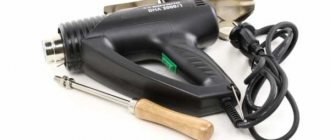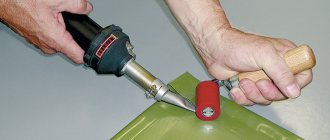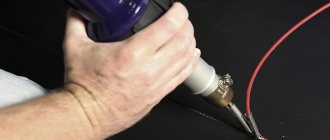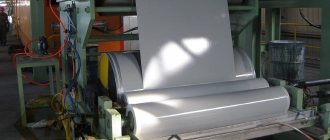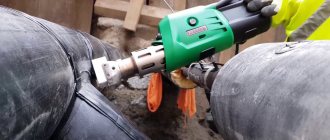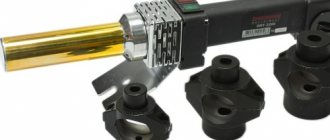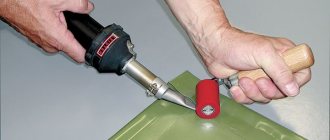In many cases, welding of polyethylene is necessary. Film of different thicknesses and textures is used in construction as a vapor barrier; it is needed in everyday life for arranging greenhouses and greenhouses. When installing individual parts, it is useless to use glue or tape: a tight connection at the molecular level provides only a hot connection.
Manufacturers produce equipment of various modifications. It is not advisable to purchase it for personal purposes; to use it, you need skills. Experts learned how to install plastic film at home using household appliances. The soldering iron and iron, after a slight improvement, replace the factory-assembled tool.
Professional welding devices
For large-scale work (for example, to create covers for large greenhouses or for commercial activities), it is recommended to use professional polyethylene welding devices.
The advantages of these devices are that they allow flexible adjustment of parameters of pressure, temperature, and speed of movement along the seam. If you are working with the same batch of polyethylene, then by setting the required values once, you can carry out the welding process at high speed. Devices for welding often have setting and tension rollers, which allow the film sheets to be connected to be pulled at the same speed, which has a beneficial effect on the final quality of the seam.
Industrial devices are produced in various types. They can have contact heating or heating carried out by hot air.
Working with large areas of material is economical when choosing a welding connection, since there is no need for adhesives or tape. Productivity and accuracy of work increases significantly. The low melting point and flexibility of the material allows the connection to be made by welding at home. The resulting joint strength mainly depends on the temperature and cleanliness of the surfaces being joined.
Methods and methods for welding polyethylene film
Welding polyethylene is the process of joining individual sections of material by heating to the melting temperature and compressing the layers. When the surfaces of the film are melted, the layers are connected at the molecular level, the result of this procedure is a welding seam. In order for the quality of the weld to be high and it to be as strong and reliable as possible, it is necessary to select good equipment, strictly follow the welding technology and not make mistakes with the heating temperature. This indicator should vary between 130-160 °C.
Note! If uncleaned areas are welded, then you should not be surprised at the low quality of the joints. Dirt particles entering the molten mass destroy the molecular structure of the seam.
That is why welding of polyethylene film must be carried out in strict compliance with a number of conditions:
- pieces of materials belonging to the same production batch must be welded,
- it is important to choose the right temperature regime; if it is below the norm, the strength will be low; if the specified temperature is exceeded, the joint may be deformed,
- Another prerequisite is clean joining surfaces.
Under no circumstances should areas along the same edges be welded twice.
Also, the success of the work and the quality of the seam are influenced by the welding machine. It is important not only to choose the right device for film welding, but also to be able to handle it.
Welding parameters for polyethylene and polypropylene products
Materials Melt Flow Index (MFR)
Welding of high density polyethylene (PE-HD, HDPE)
Products made of high-density polyethylene of melting group with index 005 (MFR 190/5: 0.4-0.7 g/10 min.), group 010 (MFR 190/5: 0.7-1.3 g/10 min. ) or groups 003 (MFR 190/5: 0.3 g/10 min.) and 005 (MFR 190/5: 0.4-0.7 g/10 min.) are suitable for welding with each other. This is confirmed by the standards DVS 2207 part 1 (DVS - German Welding Association) and is confirmed in the documents of the DVGW (German Gas and Water Union).
Welding of polypropylenes: polypropylene homopolymer (PP type 1, PP-N) and polypropylene block copolymer (PP type 2, PP-C, PP-R)
The weldability of polypropylenes is indicated within the melting index group 006 (MFR 190/5: 0.4-0.8 g/10 min.). This is confirmed by DVS 2207 part 11.
Temperature of the welding process of polypropylene and polyethylene
Hot gas welding
| Air, l/min. | Temperature in the nozzle ˚ C | Gas speed cm/min | ||||
| Nozzle diameter, mm | Speed nozzle diameter | |||||
| 3 | 4 | 3 | 4 | |||
| Welding polyethylene | 60-7060-7060-70 | 300-340300-340270-300# | 10-1510-15- | approx. 10 approx. 10- | 50-6050-6025-30 | 40-5040-5020-25 |
| Welding polypropylene | 60-7060-7060-70 | 280-320280-320280-320 | approx. 10 approx. 10 approx. 10 | 50-6050-6050-60 | 40-5040-5040-50 |
Welding with a manual extruder
| Extrudate temperature measured at the nozzle outlet, º C | Air temperature measured at the warm air nozzle, ºC | Air quantity, liters/min. | |
| PE hardPP | 200-230200-240 | 210-240210-250 | 350-400350-400 |
Effect of humidity
Products being welded (sheets, plates) and welding rod made of polyethylene and polypropylene can, under certain conditions, absorb moisture. Studies by a number of manufacturers have found that polyethylene and polypropylene welding rods absorb moisture depending on the material and environment. In extrusion welding, the presence of moisture may appear in the form of pits in the weld or a rough weld surface. This phenomenon intensifies with increasing seam thickness.
In order to prevent such undesirable consequences, the following recommendations have been developed:
- Installation of moisture and oil separators in the air supply system,
- Avoidance of significant temperature differences between parts being welded (condensation moisture),
- Storing the welding rod in a dry place if possible,
- Drying the welding rod at a temperature of 80°C for at least 12 hours,
- Welding wide seams (>18mm) in several passes.
Depending on the type of heating of polypropylene and polyethylene, the following types of welding are distinguished:
- Welding thermoplastics with hot air (hair dryer)
- Welding thermoplastics with an extruder
- Welding thermoplastics using a heating element
- High frequency welding of thermoplastics
- Laser welding of thermoplastics
FAQ on PVC welding equipment.
Where can I get advice on equipment for PVC welding?
If you have any questions, call our consultants +7(495)943-89-96. Our specialists will answer ANY questions about PVC welding equipment from Leister.
How to buy a set of equipment for PVC welding?
Buying a set for PVC welding is very simple: 1. Send your company details by E-mail and indicate in the letter “Set of equipment for PVC welding”. 2. Pay the invoice. 3. The delivery department will deliver the kit directly to your office (free in Moscow), or deliver it to your city by a transport company of your choice (at the transport company’s tariffs).
What are the prices for PVC welding equipment?
Prices for hair dryers are indicated in the online store www.mikst.ru. You can click on any item that interests you and see prices.
Why are Leister PVC welding machines so expensive?
Indeed, Leister tools and equipment are much more expensive than the manufacturers' analogues. But believe me, Leister quality is worth it! All equipment is made from high quality materials and thoroughly tested at the manufacturer. Welding machines and hair dryers from other manufacturers cannot work an 8-hour shift without changing their characteristics. Most of the industrial hair dryers offered on the market will begin to reduce the temperature of the air flow within a few minutes after starting work, because... It's just that the electronics are already overheated. And this in turn leads to poor-quality work results. Therefore, Leister industrial hair dryers and attachments are chosen by professionals who want to get a high-quality welding gun that will work for many years and will never let them down.
What other models of welding guns are on sale?
You can view the full catalog of industrial hair dryers in the online store (and also find out the cost): catalog of industrial hair dryers.
How is the PVC welding kit supplied? Will it be damaged during transportation?
The set comes in a plastic case. So it is reliably protected during transportation. A separate case is supplied for a set of welding gun + attachments. If the kit includes an automatic welding machine, it is supplied in a separate plastic case. We always include official warranty cards for Leister equipment in the kit.
When you copy a link to the source is required !
Welding with rod
For example, when laying PVC linoleum, welding using a filler rod is required. Linoleum is pre-prepared. It should be laid firmly on the floor.
All joints must fit without creating cracks or gaps. A high-quality seam without the use of special equipment is very difficult. A regular hairdryer is not capable of doing this due to the significant thickness of the linoleum.
Requires special tools and equipment. Before welding with a rod, the edges must be prepared; the molten rod will ensure their reliable connection. The resulting deposits are removed with a special knife.
PVC welding machine.
For welding banner fabric in large volumes, the Mixt company offers specialized welding equipment, specially adapted for welding PVC. The most popular model on the Russian market is the Miller Weldmaster T-300 Extreme.
T-300 Extreme is a new development from Miller Weldmaster. Designed for welding PVC products. T-300 Extreme combines unique parameters: ergonomics, easy interface, speed, accuracy and productivity. T-300 is used in various fields:
- Production of advertising banners and banners
- Awnings for cars, tents, etc.
- Inflatable products for children (circles, inflatable attractions, etc.)
- Inflatable boats and inflatable life rafts (PSN)
Welding with a soldering iron
An ordinary electric soldering iron is also suitable for bonding film at home. It is best to put a tip with a student or poster pen made of metal on its sting. If the polymer is burned through, the tip is slightly moved from the tip of the device - this reduces the heat transfer area.
Soldering is more reliable if you attach special rollers to the soldering iron. The tip is ground off until it stops, a groove is cut in the center of the end, for which a hacksaw is used. You will need a copper disk with a diameter of 1 cm (those who are serious about building such a device can grind it themselves).
Drill a hole with a diameter of approximately 5 mm to attach the axle, insert the disc into the slot made and secure it. It should rotate freely. To ensure an even weld, guide it along a ruler. The device must be guided to the point where the seam ends, without tearing it off, with pressure. This approach is most often used for sealing bags. To get a beautiful seam, practice a little on unnecessary pieces.
Homemade welding machine
To weld packaging bags, book covers and notebooks in small quantities, you can make a film welding machine with your own hands. It consists of a base on which a rail is placed, compressing the edges of the film. The base can be made of aluminum sheet about 2 mm thick. Its dimensions may vary. For example: 500x250 mm.
An aluminum corner with shelves of 20-25 mm can serve as a pressure rail. The end of the rail is secured with a screw. A spiral spring is installed between its head and the rack itself. It should make it possible to lift the rail while loading the film into the machine, and then press it to the base.
Welding of polyethylene film proceeds as follows: the sheets are laid under the rail and pressed against it. The excess is trimmed so that there are edges protruding by 1-2 mm. They are melted by the flame of a gas stove, candle, alcohol lamp or lighter. The result is a thin seam that resembles a transparent roller.
Welding polyethylene using a heating element (Butt Welding)
Polyethylene welding using a heating element (also called butt welding) is used for welding plates, blocks and other semi-finished profiles. This type of welding is extremely widely used for welding pipelines made of thermoplastics. Unlike the previous two welding methods, this method does not require the use of filler material.
For welding using a heating element, the so-called. machines for butt welding, the principle of operation of which (heating using a heating element of various shapes) is the same, and differing only in the type of drive (manual, mechanical, pneumatic, etc.) that transmits shear force to the elements being welded. In addition, butt welding machines may be equipped with special equipment and various options - for example, for welding sheets at an angle, for rolling up the sheets being welded.
Some types of butt welding machines, in addition to HDPE, can also weld HMPE and UHMWPE.
When butt welding polyethylene, the necessary heat is supplied directly from the heating element to the welding zone of the surfaces being joined. This achieves a more favorable heat distribution, so that no zone of the material is loaded with more heat than another. In addition, the mating surfaces of the heating element must be clean and completely adjacent. This type of weld exhibits little internal stress and can be loaded in much the same way as the original material.
Using a soldering iron to weld film
Connecting sheets of polyethylene using a conventional soldering iron (40-60 W) allows you to obtain a strong seam, which will require minor modification of the tool. Using a soldering iron without special attachments will not give high-quality results. The joint will be uneven, and there may be places where the material will spread.
Film welding scheme.
To obtain a good result and weld joints of significant length, you will need to use additional devices. There are several options for modifying the soldering iron.
Take a regular soldering iron, then remove the end of the tip. A cut is created using a hacksaw. After this, a copper or aluminum plate is inserted into the cut and secured with a rivet. The surface of the plate is processed, its edges are rounded with a file. Welding is carried out by slightly pressing the soldering iron at an angle of 45° and moving it evenly.
Temperature and pressure are selected experimentally. When creating a joint, it is recommended to place a flat wooden or textolite substrate under the bottom layer of film, and center the soldering iron on a flat block. In some cases, thin paper will be placed between the plate and the film. This is relevant if thin film is being welded. After creating the seam, the paper is carefully separated.
An approximate sample of a nozzle is shown in Fig. 1 (1 – plate; 2 – soldering iron and its rod).
Ultrasonic welding diagram.
It is possible to install the disk in a separate tube-tip, and it, in turn, is put on the soldering iron tip. Welding pieces of film is carried out by rolling a heated soldering iron to the required distance. The amount of pressure is adjusted depending on the welding of the seam. This method allows you to carry out a significant amount of work.
Principle of operation
Sealing of packages occurs in several stages:
- Select sealing bags that are suitable in size and composition.
- Turn on the device by pressing the handle, the light should light up.
- Open the lid.
- Place the two ends of the film on the heating surface. Close the lid.
- Click on the “Spike” button. The bag sealer heats the material to a partial melting temperature. Thanks to this they connect.
- When the indicator light goes out, the process is over. Repeat for the other two sides.
- Place the finished product in a package sealed on three sides. Place the fourth edge of the polyethylene on the heating surface. Close the lid.
- The sealing of the products is completed.
The bag sealer can glue any polymeric materials – polypropylene, polyethylene, shrink film.
Interesting: the name welding is more appropriate for the process of soldering polyethylene, since the film is joined using solder, and the particles of the material penetrate each other (diffusion process). But more often the name “sealing” is used.
DIY film soldering
Polyethylene pipelines are installed in two ways: using fittings and flanges or several types of welding.
The connection requires special fittings (couplings and sockets) and without them. For pipes with a wall thickness less than 4.5 (diameters 50-110 mm), welding using fittings is used; for larger pipes with a thicker wall, butt welding and extruder welding are acceptable.
Diffusion
The diffusion method involves heating the ends to a viscous flow state. The prepared ends of the workpieces are joined and slightly compressed. Movable polymer molecules, under the influence of pressure, move into the parts being connected, mix, freeze in a new position when cooled, form new chemical bonds and ensure reliable adhesion of the pipes to each other.
Bell method
Not the most typical way. There are two options for implementation: using socket pipes and couplings. The method itself is reminiscent of welding polypropylene pipelines: the socket or coupling and the workpiece are heated using a soldering iron with a special nozzle.
Then the workpiece is inserted into the socket of another pipe or coupling, fixed, pressed and held. Welding time – 20 seconds. If couplings are used, then the second pipe is soldered into the coupling in the same way. The cost of couplings is low; products with a socket are rarely found in stores.
The connection is reliable and durable; small diameters can be welded.
Butt welding
Before carrying out work, cut off the polyethylene pipe strictly perpendicularly and thoroughly clean the ends. Then fix the pipe in the welding machine and carefully center it.
Cool the joint, then remove the machine. The work has its own subtleties; it requires two people.
Extruder welding
Extrusion - welding using a small apparatus from which molten polyethylene is extruded under pressure. Raw materials in the form of rods or granules are loaded into the extruder.
Extrusion is used on pressure communications with a wall thickness of more than 6 mm, but it can also be used to patch non-pressure sewer pipelines with a thinner wall. The connection point is heated by a stream of hot air.
It is advisable to chamfer the ends.
PVC welding machines.
Below is a basic set of machines for welding PVC and the necessary accessories and attachments. The set includes a modern technical hair dryer Leister Triac S, basic welding attachments, Uniplan or Leister Twinny T welding machines (to choose from). We deliver the entire set in original plastic cases from Leister.
| Reliable, inexpensive multi-purpose hand-held device with smooth temperature control. Bestseller! Leister Triac S hand dryer |
| Instead of Triac S, it is possible to supply Triac ST - a new, ergonomic, reliable, modern, inexpensive multi-purpose hand-held device with smooth temperature control. New for 2013! Leister Triac ST hand dryer |
| Leister 107.123 - Crevice nozzle 20 mm for overlap welding for Triac and Diode machines. Leister 100.303 |
| Leister 107.132 - Crevice nozzle 40 mm for overlap welding. Leister 107.132 |
| Leister 140.160 - Silicone stitching roller 40 mm. Leister 140.160 |
| Leister 140.161 - Silicone stitching roller 28 mm. Leister 140.161 The set can be equipped with only one of the rollers (40 or 28 mm) at the request of the customer. |
| Leister 106.972 - Stitching roller made of brass 6mm. Leister 106.972 |
| Leister 107.562 - Leister Twinny T welding machine (230 V, 2300 W) with a combined wedge. Leister Twinny T (various versions of automatic welding machines for PVC welding are available) |
| Leister 115.049 - Automatic welding machine Leister Uniplan S (seam 20 mm, 230 V, 2300 W). Leister Uniplan S (optional) |
Tools and devices
Soldering with an iron
This is a fairly simple way to connect parts of fabrics, because household irons are found in almost every home.
To connect polyethylene in this way, you need to place a wooden block on the table. The edges of the joined canvases are located on this unique stand.
They should protrude from the edges of the block by twenty millimeters. The top of the polyethylene is covered with a sheet of refractory material (cellophane, fluoroplastic film).
The formation of the seam can be accelerated by subsequent cooling. To do this, after exposure to high temperatures, the joint is treated with a wet rag.
When passing over the joint, the iron tilts five degrees. You need to move it slowly along the joint. Once is not enough to form a strong seam; the procedure must be repeated about four to five times.
Also, to work with the iron, special soldering nozzles are used, which are fixed on top of the device. They have a flat, ribbed base.
Soldering with a soldering iron
To weld two sheets of film, a home soldering iron with a power of 40-60 W is used. However, this device requires some improvement to perform such a job.
To work with polyethylene material, the end of the tip is removed from the soldering iron. After this, a cut is created into which a plate of aluminum or copper is inserted. The plate is secured with a rivet, processed and rounded with a file.
The impact on the joint of the canvases is made at an angle of forty-five degrees. The soldering iron is pressed against the surface, and then slowly moves along the joint. The movement should be uniform, without jerks or stops.
The wheel is a disk with a diameter of eight to ten millimeters. The disc material can be aluminum or copper.
You can make it yourself. The metal wheel is placed in the cut, in which it is secured with an axle. The method of joining with a wheel is based on heating it and then rolling it along the joint.
Special equipment
Forethought is required when selecting equipment
It is important to consider the complexity of the work. To cope with large volumes of films, industrial equipment is used
Special devices are used to join polyethylene. Their prices vary. It is worth noting the budget model PP-40.
It allows you to get an even and durable seam on any contour: straight or complex. PP-40 is shaped like a soldering iron, but has a different tip.
They also use special attachments for electric irons. They are made from sheet metal, such as aluminum. The base of the nozzles is made flat and ribbed. This surface firmly fixes the film joint during welding.
The edges of the film are secured with ribs. Then move the strip along the area to be welded. This creates a double seam.
Large jobs require the use of more serious tools. To create a large-area film joint, you will need special welding equipment.
Such equipment is equipped with settings for the level of pressure, temperature, and the speed of movement of the heated element along the surface of the polyethylene. In household options for forming film seams, there are no such functions.
In addition to setting regulators, soldering machines are equipped with roller mechanisms. These are setting and tension elements that stabilize the speed of advance of the film sheets being welded.
This improves the quality of polyethylene soldering and increases the strength of the connection.
There are devices that use different heating methods: air and contact. Air heating is produced by exposing the material to hot air. Contact involves a heating element in contact with the material.
How to choose a bag sealer
To choose the right bag sealer, you need to consider several points:
- packaging material. LDPE or HDPE polyethylene, polypropylene, BOPP, multilayer film - not every machine can solder these polymers. Therefore, it is important to read the instructions for use;
- film density. The device is designed for a certain thickness of the package. It is better to take a device with high density parameters, taking into account the folds of the package;
- package size. One machine can seal bags of different widths and lengths;
- view of the finished seam. The seams can be cut, flat, embossed, or euro-seams;
- engraving. You can put a logo, production date, series, batch number or other required information on the soldered seam;
- presence of a thermal knife. If you need to automatically cut off excess parts of the package or make the packaging look perfect, you can look for devices equipped with a mechanical knife;
- sealing speed. If you need a small number of sealed bags, a manual tabletop sealer is suitable, and if the scale of production is large, a conveyor machine would be the best option.
Using an iron as a welding heater
The next popular method is to melt the film and create a joint using an iron. The advantage of this method is that large areas of the film can be welded in this way, while creating the desired seam width. Since any iron has a thermal relay and the ability to regulate the temperature, choosing the required thermal mode for polyethylene of various thicknesses is not difficult.
The welding process is best carried out on a smooth wooden surface. Pieces (sheets) of film are overlapped, the width of which is selected individually, then the top layer is covered with paper or a fluoroplastic sheet, after which it is pressed and the iron is drawn along the welding line. The clamping force, speed and temperature are selected experimentally.
The nozzle is made of brass, copper or aluminum.
Options for plastic welding equipment.
Hair dryers for welding PVC.
The set presented above includes the Leister Triac S industrial hair dryer. This is a reliable and time-tested device. It has a temperature control accuracy of +/- 10 degrees. In some cases, this may not be enough to accurately set the temperature. If you need more precise temperature control, we recommend using a Leister Triac PID industrial hair dryer. This device has a temperature control accuracy of up to 1 degree Celsius. In addition, it has a digital display that shows the set and current hot air temperature. You can also consider the Leister Hot Jet S welding gun, which is lightweight and thereby reduces the fatigue of employees working with PVC welding.
Automation of PVC welding.
The PVC welding kit includes Leister Uniplan or Leister Twinny T welding machines. These are professional and expensive welding machines.
If you need a simpler solution, we recommend Leister Triac Drive. If you are interested in any other options for automating work, then you can familiarize yourself with them in the Leister welding machines section.
